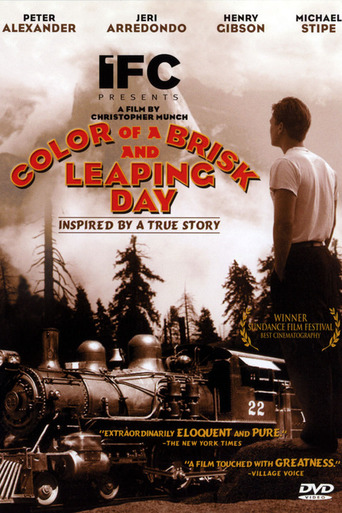joe
One of the most subtly moving films I have ever seen.It doesn't tell you what to think, it doesn't tell you what to feel; it doesn't tell you anything at all. And for some people that is unbearable. But, it gives you everything.This film, widely forgotten by many yet passionately loved by a few, ends with a poem which has proved presciently self-referential:Lo! some we loved, the loveliest and best That Time and Fate of all their Vintage prest, Have drunk their Cup a Round or two before, And one by one crept silently to Rest. --The Rubaiyat of Omar KhayyamI am glad films like this were once able to be made. Perhaps they still can be made, I don't know. This one is a beautiful gem.
Scoats
I liked this one a lot. Definitely not an everyday story, and it was told well. The pacing was excellent. The bit with fancy private rail car to go to Washington DC seemed a bit forced, like "hey we've got a fancy private rail car we can use, let's write it into the script!" I had no issues with the acting. Well maybe Michael Stipe was too Michael Stipe in his role.This is a nice little movie. It looks cool, like Jim Jermish's one with Johhny Depp as the accountant in the old west.90 minutes well spent.
jim-314
This is among the most beautiful films of the last decade, in more ways than one. I was lucky enough to see the film once in the theater. I wanted to own a copy. It was a long time coming to DVD but I recently learned that it was finally available, and so I purchased a copy. The absolutely extraordinary cinematography by Rob Sweeney doesn't hit you on a TV screen with quite the same punch that it does on a full sized theater screen, but even so, first time viewers should still get a good sense of just how visually exceptional this movie is. The movie has many virtues, the greatest of which is probably its look. Even when showing us ordinary domestic details the black and white photography has a luminous, magical, dream-like quality that is magnified all the more when the camera turns to the natural spectacle of Yosemite park where most of the movie is set. Not only does the texture of the imagery make you want to bathe your soul in it, but every frame, without exception, is as beautifully composed as any produced by the great directors and cinematographers of the 30s and 40s. Additionally, the movie integrates documentary footage from the late 40s with seamless technical facility. Aside from the look of the film, the story movingly follows the obsessive dream of a young man who tries to rescue a defunct pre-World War II short-line railroad. His effort arises partly from his interest in engineering, partly from what he seems to view as a proper way to live in the world, and partly from his grandfather's experience as an early railway laborer. His story is bound to touch anyone whose obsessions (professional or aesthetic) have ever been viewed with distrust or contempt by those around him, anyone who has found value in something others reject, and anyone who does not necessarily believe that all progress is good progress. That he fails in his mission is inevitable; that the inevitability of his failure seemed clear from the start, perhaps even to him, only makes his story more moving. Other interesting elements of the movie include the relationship of the main character with a loner (Michael Stipe) that gently hints at the blurred lines between friendship, professional association, and sublimated romance. The movie's matter-of-fact presentation of late-40s bigotry directed at Asian-Americans is yet another of its uncommon background elements. If you want some sort of fast-paced action, or a plot that tells you exactly what you should think, look elsewhere. If you want an exceptional example of visual storytelling that integrates the historical and the personal and is rich in ambiguities, you can hardly do better than "The Color of a Brisk and Leaping Day."
D. Richard Carlson (dmaestoso)
Film begin with quote taken from Matthew 13:46. "Who, When he had found one Pearl of Great Price, went and sold all that he had and brought it."Very moving railroadmania theme, particular with revolving familiar Los Angeles scene, ie. Los Angeles Passenger Union Terminal (LAPUT) name. Pacific Electric's downtown streetcar routes which aren't there anymore and maintenance shop is a rare interesting layout. Right theme and excellent scope on begone Southern Pacific Railroad (also owned Pacific Electric) exposing former corporate culture. Good job, I think, with historical restoration and award-winning 1996 Sundance Cinematography Award led me to wrongly believe that this film took place in 1950's, era which part of nationwide customary act to abandon railroad lines. Great film to watch those with an entrepreneurial mind with preservation cause.


